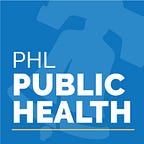COVID-19 Impact by Age and Race/Ethnicity in Philadelphia
Philadelphia, like much of the rest of the United States and the world, has suffered from the impact of the COVID-19 virus. Thanks to Philadelphia residents, businesses, and healthcare providers who have followed guidance, including a citywide Stay-at-Home order, school closures, a universal masking order, case rates fell in the late Spring and Summer.
In the U.S. and other countries, people from non-white racial and ethnic groups and older adults have suffered the greatest impact of COVID-19. This CHART explores the differences that we have seen in Philadelphia throughout the pandemic through August 31, 2020. This report relies on information that the Department of Public Health collects on tests performed, the results, and the characteristics of those tested. The graphs below show weekly rates of COVID-19 measures per 10,000 residents.
How has COVID-19 impacted Philadelphians of different races and ethnicities?
African Americans
More African American residents have been tested for COVID-19 than any other race/ethnic group. As of August 30th, 2020, 100,871 of the 316,580 tests (32%) performed have been on African American residents. The highest COVID-19 infection, hospitalization, and death rates in Philadelphia are in African Americans.
Latinx
Despite comparatively low testing rates over time, the overall rates of infections, hospitalizations and deaths among Latinx residents are second only to those of African Americans. Since May, Latinx have often had the highest rates of infections, hospitalizations, and deaths.
Asians
Early on, Asian residents often had higher rates of infections, hospitalization, and deaths than white residents, but these have been similar or lower since late May. COVID-19 testing among Asian residents has never been very high.
Whites
To date, white Philadelphians have experienced lower rates of infections, hospitalizations, and deaths than other races/ethnicities. Recent increases in testing among white Philadelphians could be due to screening before medical procedures.
Unknown Race and Ethnicity
Laboratories often do not include race and ethnicity when reporting test results. In June, we required reporting of this information due to questions around disparities in COVID-19 outcomes. We still often lack this information.
How has COVID-19 impacted Philadelphians of different ages?
Older Adults
As older adults are considered at high risk for severe outcomes from COVID, testing rates in these age groups have consistently been the highest. This trend is in part driven by testing of residents of nursing homes. COVID-19-associated hospitalization and death rates have consistently been highest among those age 75 years and older. Fortunately, since May, rates of infections, hospitalizations and deaths in older adults decreased dramatically and have remained low.
Other Ages
Generally, COVID-19 infection rates have been highest among those aged 35 to 74. Since July, infection rates have been the highest in those aged 20 to 34 years. Infection rates for those under 20 years have been consistently low, but so has testing in this age group. A single peak of COVID-19 infections was observed in teens in June coincident with high school graduations. With the start of the school year, the health department will watch closely the number of infections in children.
What about the impact of COVID-19 by age and race?
Please refer to our testing and data page to see data on COVID-19 hospitalizations and deaths in older adults by race/ethnicity.
What can be done
The Health Department is:
- Posting data on the COVID-19 pandemic by race and ethnicity.
- Working with City, nonprofit, healthcare, and academic partners to develop and publish metrics for the Coronavirus Racial Equity Plan.
- Working with other organizations to expand testing, particularly to populations at highest risk.
- Sharing multi-lingual information about testing including sites that do not require a car on Phila.gov/Testing.
- Conducting case investigation and contact tracing through a diverse, multi-lingual team with the people skills to build trust with community members.
- Actively recruiting community partners to provide one or more support services such as food delivery or assistance with benefits applications to people isolating or quarantining at home because of COVID-19 infection or exposure.
- Developing policies and disseminating guidance for organizations to reduce the risk of spread of COVID-19.
- Promoting mask use through a mass media campaign.
- Disseminating clear, simple, multi-lingual materials about the COVID-19 pandemic through community partners, food distribution boxes, social and mass media, and community meetings.
- Sharing information about worker protections with frontline workers and distributing reopening guidelines to employers across the city.
- Providing technical assistance to nursing homes and other group living sites to help prevent the spread of COVID-19 at these high-risk sites.
Health care providers should:
- Offer testing in the office to patients who present with symptoms of possible COVID-19 and to those who have been exposed to someone with COVID-19.
- Sign up for the PDPH Health Alert Network to ensure you are up to date with recent developments.
- Ensure that your staff wear masks consistently while in the office except while taking breaks at least 6 feet from others and that you are following recommended infection control procedures.
People can:
- Wear a mask whenever you are around people who you do not live with.
- Stay at least 6 feet from people who you do not live with.
- Wash your hands frequently with soap and water for at least 20 seconds or use hand sanitizer.
- If you have symptoms of possible COVID-19, get tested, but otherwise stay home and away from others in your household.
- See the City’s COVID-19 website for information on COVID-19 safety.
Resources
City of Philadelphia COVID-19 webpage:
https://www.phila.gov/programs/coronavirus-disease-2019-covid-19/
Suggested citation: Philadelphia Department of Public Health. COVID-19 Impact by Age and Race/Ethnicity in Philadelphia. CHART 2020; 5(7):1–5.
CHART is a publication of the Philadelphia Department of Public Health, and is intended to highlight under-reported or under-appreciated public health issues in an effort to kick-start a conversation. Readers can subscribe to CHART on Medium, or on our website.
